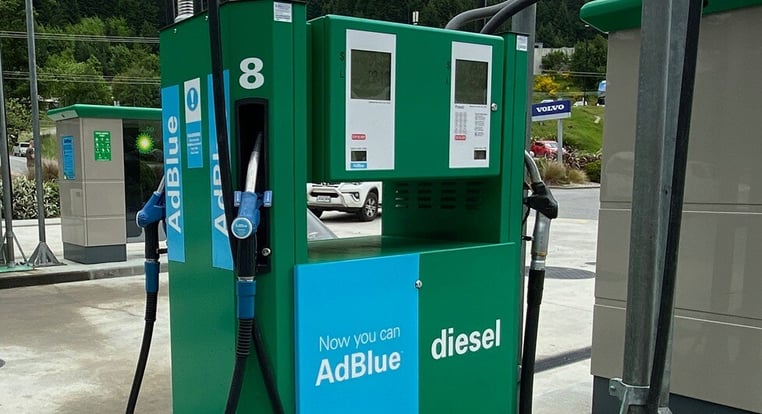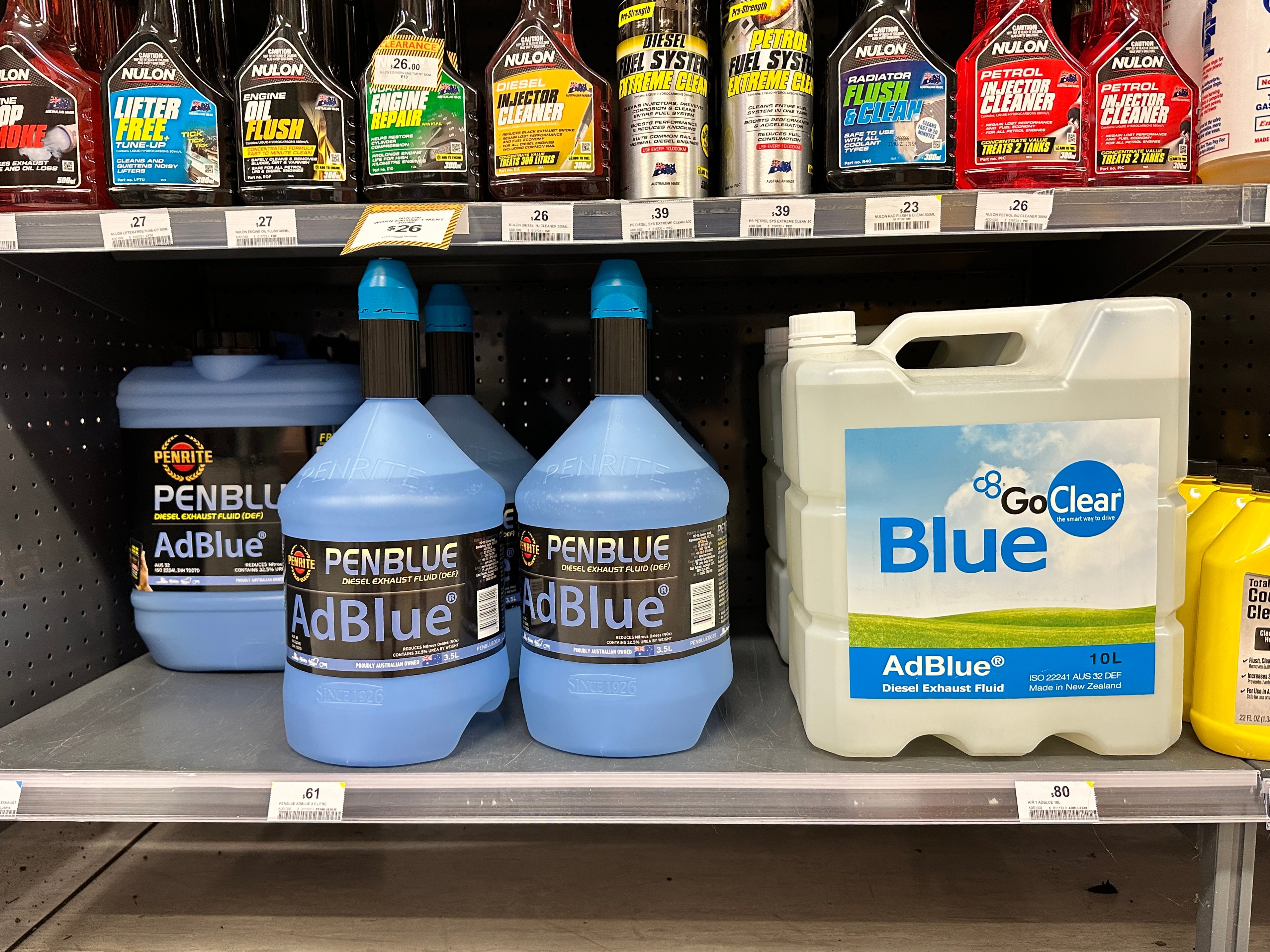Ask any long-haul trucker whether AdBlue has made their work environment more pleasant and they’ll likely say too right, that stuff is magic — or words to that effect.

Most diesel-powered motorhomes and campervans that meet the Euro 6 emission standard will come with an extra tank, specifically for AdBlue. An additive, it removes the offensive smell of diesel exhaust gases — so you’ll breathe easier near a Euro 6 diesel engine idling at a campsite.
What is AdBlue?
AdBlue is a clear harmless liquid used to reduce the amount of air pollution created by diesel engines. AdBlue (or its more generic name of AUS32) is made up of:
- 67.5 percent deionised water
- 32.5 percent aqueous urea solution.
Significant reduction in pollutants
AdBlue is injected post-combustion into the stream of gases flowing through the exhaust system — converting harmful nitrogen oxides (NOx) into harmless nitrogen gas and water vapour.
The process drastically reduces the amount of NOx your engine will emit. This enables it to meet the Euro 6 emission standard by achieving a 56 percent reduction on the maximum NOx emissions permitted under Euro 5.
Particle filters also required by Euro 6 trap any toxic soot before it reaches the atmosphere.
See how motorhomes may be affected by the clean car standard.

Easy to fill up
In a van-based motorhome AdBlue is usually stored in a 15-18 litre tank that’s mounted alongside the fuel tank. This generally allows the AdBlue and diesel filler caps to be located alongside each other and protected by the same locking flap.
The smaller filler cap to the AdBlue tank is coloured blue. It’s sized so that the liquid can be added easily via the AUS32 pumps that are often found at truck stop refilling stations in New Zealand.
|
💡AdBlue Tip If AdBlue gets in your fuel tank by mistake, don’t start the engine. Instead, ask the gas station attendant for help. |
The cost of AdBlue
It can be difficult to determine how much you’ll need to budget for AdBlue due to a variety of factors. The most cost-effective way of buying AdBlue is from a dedicated pump at a truck stop. At the time of writing, it cost between $1.75 and $2.50 per litre. The alternative is to purchase it in a container from a gas station or automotive accessory outlet for around $40 for a five litre container.
A litre of AdBlue will last between 100km and 500km of motorhome travel, depending on the:
- Efficiency of the injection system
- Driving style and type of road the vehicle is travelling on.
Some owners report that highly efficient new-age 2L diesel engines with ultra-precise AdBlue injection systems consume roughly half the amount of AdBlue as less efficient 2.2L diesel engines.
Although it’s tricky to estimate the actual rate of consumption of AdBlue, we can create an arbitrary example — though your own vehicle may be quite different.
Based on an average cost of three dollars per litre and an average consumption of one litre every 200km, you can calculate how much AdBlue your Euro 6-compliant RV will use. For example:
- Travelling 5,000km will need 25 litres of AdBlue at a cost of $75
- Driving 15,000km will consume 75 litres at about $225.
The larger the load on your diesel engine, the more AdBlue it will consume. If you’ll be driving through hilly, winding terrain (or towing) you can expect the amount of AdBlue being injected into your exhaust gas stream to increase.
Learn more about the ongoing costs of owning a motorhome.

When to fill up
Expect plenty of warning when your motorhome or campervan’s level of AdBlue is getting low.
Some provide access to an AdBlue tank gauge via their digital instruments — like those based on the Mercedes Sprinter van and the new Fiat Ducato Series 8. However, most simply display an early warning message on the dash that it’s time for an additive top-up.
If you’re the owner of a new motorhome, you may not need to add AdBlue yourself during your initial period of ownership. Warranties usually require new vehicles to be serviced annually — and the AdBlue tank will be topped up as part of your motorhome’s annual service.
Planning to travel less than 15,000km per year during the warranty period? It’s likely the service department will take all responsibility for ensuring that the additive tank is refilled.
Find out what you should know about motorhome warranties.
How AdBlue works
Importantly, AdBlue should never be treated as a diesel fuel additive — it has its own separate tank. After you’ve filled yours at a gas station with an AdBlue dispenser and hit the road, the following steps take place.
- A small but constant spray of AdBlue is injected in a precisely measured manner into the exhaust gas stream as it passes through the catalytic converter.
- The AdBlue reacts with most of the NOx passing through.
- Nitrogen and oxygen molecules are separated apart to create pure nitrogen gas and water vapour.
Where you can get AdBlue
The most convenient way to refill the additive tank is by using an AdBlue pump at a fuel station. These are more likely to be found at truck stop-style filling stations rather than stations more oriented towards supplying fuel to passenger cars.
The petrol companies that list which of their stations have AdBlue available are:
AdBlue is also available off the shelf in five and ten litre containers at many other gas stations, as well as major motoring accessory chains, such as Supercheap Auto and Repco.
The ten litre AdBlue container is shaped like a cube — which can make filling the tank difficult for one person. Having a helper hold a funnel with a flexible hose in position while filling your tank is easiest.
|
AdBlue and Paint If small amounts of AdBlue come into contact with your motorhome's paintwork, wipe and rinse it off with water. |
How NOx affects the atmosphere
As far as global warming gases go, the two nitrogen oxides have catalyst-like effects on climate change. At the molecular level, the ability of each to warm the atmosphere is 300 times greater than that of carbon dioxide (CO2).
The use of AdBlue is therefore playing a key role in reducing emissions of these gases from diesel engines. However, diesel combustion still plays a greater role in transport-related emissions of NOx than petrol.
The effect of NOx on human health
Nitrogen oxides and their byproducts (nitric acid and ozone) can cause serious damage to lung tissue. Even short-term exposure can affect healthy people — and those with medical conditions such as asthma, bronchitis and emphysema are highly vulnerable to these air pollutants.

What happens if your AdBlue tank is empty
It’s highly unlikely that you’ll ever be caught with an empty tank of AdBlue. Motorhome manufacturers ensure fail-safe systems are in place to help prevent running out of the blue magic, which includes:
- Showing a warning — this displays on the dashboard when the tank has either two or five litres of AdBlue remaining (depending on the make and model)
- Becoming unresponsive — if the warning’s ignored, your motorhome probably won’t start once the tank sensor registers that only a tiny residue of AdBlue remains
- Limiting power and speed — if the AdBlue level drops to zero in a Mercedes Sprinter van, you’ll only be able to drive 19km per hour until it’s refilled.
For Fiat Ducato vans, you’ll need to add a minimum of five litres of AdBlue when the warning light comes on.
If you’ve just refilled your AdBlue tank with the warning light on, turn the ignition to the on position and wait for the light to turn off before starting your engine. This could take up to two minutes.
Even with this unlikely scenario, try to plan where you could top up your AdBlue tank before the warning light comes on. If your AdBlue tank should reach empty, you won’t be able to restart the engine.
See our advice on how to improve your motorhome’s fuel efficiency.
|
AdBlue is an environmentally responsible choice. Speak with our team for advice on choosing a motorhome that takes AdBlue. |





